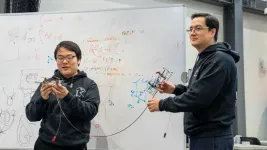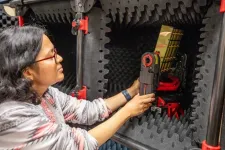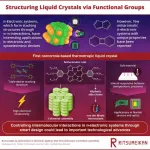(Press-News.org) Lupus is a lifelong, often painful and occasionally lethal autoimmune disease. Few treatments exist today beyond powerful steroids to knock down a patient's immune system — a therapy that has its own serious risks.
The good news is that new and promising treatments are in clinical trials. But the term lupus belies the fact that the disease has a variety of causes, which means that treatments will have to be highly personalized to guarantee that each patient is given the drug that targets the specific genetic mutation responsible for their variety of lupus.
Researchers are just now beginning to link specific genetic mutations to subsets of lupus patients, allowing physicians to target therapies to those who will benefit most. In the latest advance, researchers at the University of California, Berkeley, report in a new paper the discovery of two sets of patients with genetic mutations that are nearly identical to mutations that the researchers had earlier pinpointed in mouse and cell lines as linked to autoimmune disease.
These two genetic links are among several dozen mutations that the UC Berkeley team recently discovered and linked to lupus, all in one gene that regulates a prime suspect in a subset of lupus patients — proteins called toll-like receptors (TLR), which enable immune cells to recognize foreign DNA and RNA.
According to study leader Gregory Barton, UC Berkeley professor of molecular and cell biology, identifying these mutations could help doctors deliver a personalized treatment to patients with oversensitive TLRs and, in particular, oversensitive TLR7 receptors.
"We basically have a map now," said Barton, who is also an investigator in the Howard Hughes Medical Institute. "It's not like everybody that has lupus has a mutation in the gene that causes overactivation of TLRs and TLR7. But there are drugs coming online that very specifically inhibit TLR7. As we sequence more and more people, it will become easier to identify those patients and put them on those drugs. That's a lot better than the current course of therapy for lupus, which is brutal."
"This is exciting because the drug will be orally available and is in clinical trials now," said Victoria Rael, a UC Berkeley graduate student who, with fellow graduate student Julian Yano, is a co-first author of the paper.
The results of the genetic screens and details of the patients' mutations were published today (May 23) in the Journal of Experimental Medicine.
A problem recognizing 'self'
Autoimmune diseases, which range from rheumatoid arthritis and Crohn's disease to scleroderma and numerous thyroid conditions, stem from attacks by the immune system on the body's own cells that destroy normal, healthy tissue.
Many studies have linked at least two types of autoimmune disease, lupus and psoriasis, to TLRs, which are part of the innate immune system that initially detects foreign invaders, such as viruses and bacteria, and stimulates a first line of attack. Normally, TLRs are delicately tuned to react only to foreign DNA and RNA, but if that tuning is off, they can react to a body's own nucleic acids and proteins associated with nucleic acids, which look much like those of pathogens.
What makes this autoimmune reaction so deadly is that the TLRs also activate the body's second-line defense, the more powerful adaptive immune response, mobilizing T and B cells, macrophages, and other cells. These cells then mount a sustained attack that destroys the body's healthy tissue and causes chronic inflammation.
The most common form, systemic lupus erythematosus (SLE), for example, is characterized initially by skin rashes — in particular, a butterfly-shaped rash on the face — but later by damage to joints, muscles, organs and skin, causing pain and fatigue. It’s most commonly seen in females, often starting during the teen years. Lupus, in general, is two to three times more prevalent among women from many ethnic and racial minority groups than among white women.
"We think the way the system works is that if nucleic acids find these receptors, most likely they're going to be from a virus," Barton said. "But in some people, the receptor is more responsive, so now levels of self-nucleic acids that otherwise wouldn't stimulate the receptor in a normal person activate the receptor. We think that one of the ways that these mutations are working is that they're making levels of self-nucleic acids that normally wouldn't be stimulatory, stimulatory."
Barton and his lab colleagues have been investigating the role of TLRs that are misregulated in lupus, and in particular, one of the main proteins that regulates them: UNC93B1, or UNC for short. Several years ago, a team of postdoctoral fellows and graduate students in his lab screened in cell culture more than 100 genetic mutations in the UNC gene to see which ones overstimulated TLRs and would be good targets for further study. While they published some details in earlier papers, they didn't publish the complete list because there seemed to be little point — almost no data was available on the genome sequences of lupus patients to compare with the mutations that overstimulated TLRs.
But that has changed in recent years, thanks to a plunge in the cost of genome sequencing. That's how the mother of a young girl with severe autoimmune disease found Barton. Her daughter’s DNA had been sequenced and showed a mutation in a region of UNC that Barton’s team had noted in an earlier paper.
Lupus in the family
Rael and undergraduate Madeleine Weiss used the same cell culture screening technique to test the novel mutation from the young girl and found that it had an overstimulating effect, similar to the effect of other mutations in that area of the UNC gene. Surprisingly, the patient had the genetic mutation on only one of the two UNC alleles, meaning that she had one normal UNC gene, yet she still suffered severe autoimmune symptoms.
Barton and his team also connected with a family of five afflicted with lupus. All had mutations on one UNC allele in another area of the UNC protein that Barton's team had previously identified. That mutation, when screened in cell lines, also produced overactive TLRs.
"We were skeptical that just one copy of a gene would be sufficient to cause a disease," Rael said. "It wasn't until we put the patients’ mutations into cell lines and saw that they led to very convincing TLR hyper-responsiveness that we realized they had the possibility of being sufficient to be disease-causing."
Rael and Yano then repeated the screening work previously performed in the lab and confirmed that 32 distinct mutations in the UNC gene — about one-third of the mutations tested — increased the sensitivity of TLR7 to nucleic acids at least twofold. About another five mutants increased TLR7 sensitivity but to a lesser degree. Before these screens, only two mutations in the UNC protein had been linked to increased sensitivity of TLR7 in mice, though three additional human mutations were reported within the last two months.
Barton is hopeful that by publishing the complete list of TLR hypersensitivity mutations, doctors can identify other lupus patients who could benefit from the anti-TLR drugs now in clinical trials. One drug, M5049, or Enpatoran, appears to work by latching onto two human receptors, TLR7 and TLR8, and preventing them from binding nucleic acids.
Rael, Yano and other members of Barton’s lab are investigating further how these unique UNC mutations affect the way a patient manifests the disease. They have recreated these patients’ mutations in mice so that they can model human lupus.
"With mouse models, you can start thinking about how, even though the mutations are in the same protein, the different mechanisms of TLR regulation break down, which immune cells get activated as a result, and how this can lead to differences in the symptoms patients suffer from," Rael said.
The lab also is trying to understand how UNC tunes TLRs, which may be by regulating the number and arrangement of TLRs on immune cells. More TLRs may make a person more sensitive to the small number of self-nucleic acids circulating in the body.
"UNC93B1 is important for getting the receptors to the place where they can function, but it also is important for regulating them when they get there," Barton said. "The protein is a very baroque way of trying to make decisions about whether the nucleic acid that you just bound to a TLR is from a virus or from one of your own cells."
He hopes that physicians add this gene to the list of lupus-associated genes, "so if they see a mutation like these, even a heterozygous mutation, they will investigate further."
Other senior authors of the paper are Bo Liu of the Chinese Academy of Sciences in Shanghai and Olivia Majer of the Max Planck Institute for Infection Biology in Berlin, Germany. The co-authors also include physicians from UC San Francisco, Stanford University, and hospitals in Missouri, North Carolina and Washington.
The work was funded in part by the Lupus Research Institute, the Lupus Research Alliance and the National Institutes of Health (R01AI072429).
END
Tracking down the genetic causes of lupus to personalize treatment
Genetic screen identifies many mutations associated with autoimmune diseases that could help target therapy
2024-05-23
ELSE PRESS RELEASES FROM THIS DATE:
New discoveries about the nature of light could improve methods for heating fusion plasma
2024-05-23
Both literally and figuratively, light pervades the world. It banishes darkness, conveys telecommunications signals between continents and makes visible the invisible, from faraway galaxies to the smallest bacterium. Light can also help heat the plasma within ring-shaped devices known as tokamaks as scientists worldwide strive to harness the fusion process to generate green electricity.
Now, scientists have made discoveries about light particles known as photons that could aid the quest for fusion ...
Lehigh University researchers explore innovative cable-based approach to aerial robotics
2024-05-23
When we think about drones, we tend to think about Amazon. But their potential is much greater, and arguably far more important, than dropping off a box of laundry pods by lunchtime (an idea that’s struggled to take off since Jeff Bezos floated it more than a decade ago).
Aerial robots could be a huge asset, saving time, money, and workers’ well-being, in industries like construction where humans often have to heft materials up multiple floors, says David Saldaña, an assistant professor of computer science and engineering. They could also deliver ...
Researcher charges ahead with new tech to power drones wirelessly
2024-05-23
Dr. Ifana Mahbub, assistant professor of electrical and computer engineering at The University of Texas at Dallas, has been awarded the Defense Advanced Research Projects Agency (DARPA) Director’s Fellowship to continue her research to develop wireless technology to recharge unmanned aerial vehicles (UAVs) in flight.
DARPA awards the fellowships to its Young Faculty Award recipients who demonstrate exceptional performance. Mahbub received a Young Faculty Award, which provided $500,000 over ...
Features of bloodstream infection among immunocompromised oncology patients presenting to the emergency department with fever
2024-05-23
Background and Aims
Oncology patients undergoing cancer treatment and experiencing episodes of fever are known to be at increased risk for invasive bacterial infection, including bloodstream infection. This study aimed to identify the incidence of bacteremia along with the bloodstream isolates for immunocompromised oncology patients referred to the emergency department (ED) due to fever.
Methods
Oncology patients with fever were referred to the ED according to a protocol previously reported. Virtually ...
How family economic insecurity can hurt child mental health
2024-05-23
COLUMBUS, Ohio – Economic difficulty caused by the COVID-19 pandemic led to a cascade of connected problems for some parents – resulting in mental health problems for their children, a new study suggests.
Researchers found that economic insecurity was linked to higher levels of depressive symptoms for parents, which was then associated with poorer relationship quality for the couples. That was linked with more harsh parenting and then to increased internalizing behaviors for their children.
“Pandemic-induced ...
Constantly on the hunt for food: Harbor porpoises more vulnerable than previously thought to the disturbances from humans
2024-05-23
Summer is coming and that means more boats in the sea. Danish coastal waters are especially cluttered with small boats in the summertime. Locals water skiing, going fishing or just riding around the beautiful bays and fjords.
In general people relax and have a good time on the water, but that is unfortunately not the case for the harbor porpoise.
The more motor boats speeding noisily around, the more they are disturbed. And that can be a big problem for the animals.
Because the harbor porpoise is a relatively large animal that feeds on small fish it needs to spend a lot of time hunting. New research shows that it spends around 60 percent of its time on the hunt, but ...
Producing novel liquid crystals by stacking antiaromatic units
2024-05-23
In organic chemistry, π-stacking systems are supramolecular structures that arise due to the dispersion force, a type of intermolecular noncovalent interaction. They are a common occurrence in nature; the stabilized structure of DNA is a very prominent example of a π-stacking system, and so are the arrangement of amino acids in certain proteins. Interestingly, π-stacking can be leveraged in the design of materials with useful electronic and optical properties. These include organic semiconductors of various kinds, as well as conjugated polymers for sensing and biomedical applications.
Thus far, a good portion of technologically relevant π-stacking system has been limited ...
First pictures from Euclid satellite reveal billions of orphan stars
2024-05-23
The first scientific pictures from the Euclid satellite mission have revealed more than 1,500 billion orphan stars scattered throughout the Perseus cluster of galaxies.
Led by astronomers from the University of Nottingham, this discovery sheds light on the origins of these celestial wanderers.
The Perseus cluster, located 240 million light-years away from Earth, is one of the Universe's most massive structures, boasting thousands of galaxies. However, amidst this cosmic ensemble, the Euclid satellite captured faint ghostly light - the orphan stars - drifting between the cluster's galaxies.
Stars naturally form within galaxies, so the presence of orphan ...
VIDEO: Surrey astrophysicists explore new galaxies and streams of stars using new data from Euclid space telescope
2024-05-23
As the European Space Agency publishes the first findings from its Euclid space telescope, scientists from the University of Surrey are celebrating fresh insights from the data.
Dr Denis Erkal, Associate Professor of Astrophysics at the University of Surrey, studies how the gravity of the Milky Way pulls clusters of stars apart, creating streams of stars trailing across the galaxy.
Now, his model for how this happens (video HERE) has been confirmed by data from Euclid.
Dr Erkal said:
“For a long time, my modelling ...
Scientists reveal first data from Euclid telescope offering snapshot of cosmic history
2024-05-23
Scientists have released the first set of scientific data captured with the Euclid telescope, showing an exciting glimpse of the Universe’s distant past.
The telescope, launched in July 2023, is part of the Dark Energy Satellite Mission, which aims to map the dark Universe.
Led by the European Space Agency in collaboration with The Euclid Consortium - which includes astronomers at The University of Manchester in leadership positions – the mission seeks to unlock mysteries of dark matter and dark energy and reveal how and why the Universe looks as it does today.
Early observations, described in a series ...
LAST 30 PRESS RELEASES:
Tunnel resilience models unveiled to aid post-earthquake recovery
Satellite communication systems: the future of 5G/6G connectivity
Space computing power networks: a new frontier for satellite technologies
Experiments advance potential of protein that makes hydrogen sulfide as a therapeutic target for Alzheimer’s disease
Examining private equity’s role in fertility care
Current Molecular Pharmacology achieves a landmark: real-time CiteScore advances to 7.2
Skeletal muscle epigenetic clocks developed using postmortem tissue from an Asian population
Estimating unemployment rates with social media data
Climate policies can backfire by eroding “green” values, study finds
Too much screen time too soon? A*STAR study links infant screen exposure to brain changes and teen anxiety
Global psychiatry mourns Professor Dan Stein, visionary who transformed mental health science across Africa and beyond
KIST develops eco-friendly palladium recovery technology to safeguard resource security
Statins significantly reduce mortality risk for adults with diabetes, regardless of cardiovascular risk
Brain immune cells may drive more damage in females than males with Alzheimer’s
Evidence-based recommendations empower clinicians to manage epilepsy in pregnancy
Fungus turns bark beetles’ defenses against them
There are new antivirals being tested for herpesviruses. Scientists now know how they work
CDI scientist, colleagues author review of global burden of fungus Candida auris
How does stroke influence speech comprehension?
B cells transiently unlock their plasticity, risking lymphoma development
Advanced AI dodel predicts spoken language outcomes in deaf children after cochlear implants
Multimodal imaging-based cerebral blood flow prediction model development in simulated microgravity
Accelerated streaming subgraph matching framework is faster, more robust, and scalable
Gestational diabetes rose every year in the US since 2016
OHSU researchers find breast cancer drug boosts leukemia treatment
Fear and medical misinformation regarding risk of progression or recurrence among patients with breast cancer
Glucagonlike peptide-1 receptor agonists and asthma risk in adolescents with obesity
Reviving dormant immunity: Millimeter waves reprogram the immunosuppressive microenvironment to potentiate immunotherapy without obvious side effects
Safety decision-making for autonomous vehicles integrating passenger physiological states by fNIRS
Fires could emit more air pollution than previously estimated
[Press-News.org] Tracking down the genetic causes of lupus to personalize treatmentGenetic screen identifies many mutations associated with autoimmune diseases that could help target therapy





